

Are We Losing Control? – DIGHUM. Abstract: This essay challenges the predominant assumption that humans shape technology using top-down, intelligent design, suggesting that technology should instead be viewed as the result of a Darwinian evolutionary process where humans are the agents of mutation.

Advancing Information Systems Theories Vol. 1: Rationale and Processes – Special Interest Group on Philosophy (SIGPhil) in Information Systems. Many IS researchers are looking for more substantive coverage and discussions surrounding information systems (IS) theories, not just about theories in IS research, but specifically fresh and original indigenous IS theories.
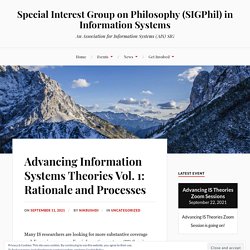
It is inconceivable for a field so relevant to the era of the hyper-connected society, disruptive technologies, Big Data, social media, the weaponization of information and “fake news” to not be brimming with its own native theories. It is towards this goal that the “Advancing Information Systems Theories” series of volumes was published in June 2021. Table of contents (Scroll below for Zoom sessions) Introduction: Why Theory? (Mis)Understanding the Context and Rationale by Hassan, Nik Rushdi and Willcocks, Leslie. Advancing Information Systems Theories Volume 1 Zoom sessions – September, 2021 Unless specified otherwise, the sessions will be recorded to allow those who are unable to join the Zoom session to watch in their own time. Home. Einstein v Newton: the final battle during a total eclipse. Usually, when scientists test a theory, they get everything nicely under control.
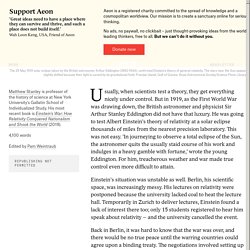
But in 1919, as the First World War was drawing down, the British astronomer and physicist Sir Arthur Stanley Eddington did not have that luxury. He was going to test Albert Einstein’s theory of relativity at a solar eclipse thousands of miles from the nearest precision laboratory. This was not easy. ‘In journeying to observe a total eclipse of the Sun, the astronomer quits the usually staid course of his work and indulges in a heavy gamble with fortune,’ wrote the young Eddington. For him, treacherous weather and war made true control even more difficult to attain.
Nobel prizes for individual scientists are an anachronism. Getting Started - Systematic Review Program - LibGuides at Health Sciences Library System. What is a systematic review?
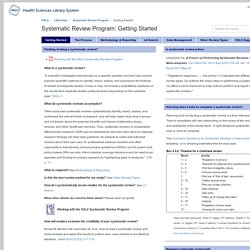
"A scientific investigation that focuses on a specific question and that uses explicit, planned scientific methods to identify, select, assess, and summarize the findings of similar but separate studies. It may or may not include a quantitative synthesis of the results from separate studies (meta-analysis) depending on the available data. " IOM p 1. What do systematic reviews accomplish? Are scientific theories really better when they are simpler? Two of Barcelona’s architectural masterpieces are as different as different could be.
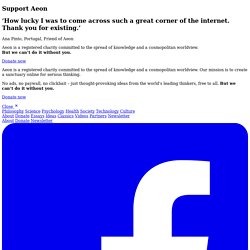
The Sagrada Família, designed by Antoni Gaudí, is only a few miles from the German Pavilion, built by Mies van der Rohe. Gaudí’s church is flamboyant and complex. Mies’s pavilion is tranquil and simple. Mies, the apostle of minimalist architecture, used the slogan ‘less is more’ to express what he was after. Gaudí never said ‘more is more’, but his buildings suggest that this is what he had in mind. One reaction to the contrast between Mies and Gaudí is to choose sides based on a conviction concerning what all art should be like. Science is different, at least according to many scientists. Digital tools for researchers. PRISMA. About - REF 2021. Reliability, validity, generalizability and credibility. Pt .1 of 3: Research Quality. Why language is not everything that Noam Chomsky said it is. Few scientific disagreements lead to public controversy.

But there are times when the subject or the participants in a debate so capture the public imagination that otherwise dry, technical matters of discord among researchers erupt into the media, eliciting a wide array of opinions from experts and non-experts. Getting the public interested is good for science if it leads to deeper thinking about things that are of importance to understanding our species. Why You Should Be Glad That Quadrotors Have Learned to Dodge Swords. When that quadrotor fencing video showed up everywhere last month, we asked Ross Allen, the Stanford PhD candidate (and fencer) responsible for the research, if he’d be willing to talk to us about it.

Research Methods. Research methods is a broad term.
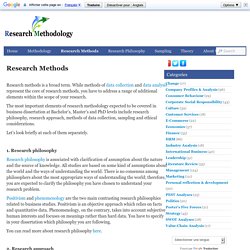
While methods of data collection and data analysis represent the core of research methods, you have to address a range of additional elements within the scope of your research. Explorable - Think Outside The Box - Research, Experiments, Psychology, Self-Help. Basic Business Research Methods. Organizations use research, especially in market research activities.
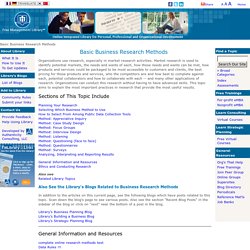
Market research is used to identify potential markets, the needs and wants of each, how those needs and wants can be met, how products and services could be packaged to be most accessible to customers and clients, the best pricing for those products and services, who the competitors are and how best to complete against each, potential collaborators and how to collaborate with each -- and many other applications of research.
Organizations can conduct this research without having to have advanced skills. This topic aims to explain the most important practices in research that provide the most useful results. Sections of This Topic Include General Information and ResourcesEthics and Conducting Research Also seeRelated Library Topics Also See the Library's Blogs Related to Business Research Methods In addition to the articles on this current page, see the following blogs which have posts related to this topic. Electronic Resources for Research Methods. Mill's Methods. Mill's Methods are five methods of induction described by philosopher John Stuart Mill in his 1843 book A System of Logic.[1] They are intended to illuminate issues of causation.

The methods[edit] Direct method of agreement[edit] If two or more instances of the phenomenon under investigation have only one circumstance in common, the circumstance in which alone all the instances agree, is the cause (or effect) of the given phenomenon. For a property to be a necessary condition it must always be present if the effect is present. Since this is so, then we are interested in looking at cases where the effect is present and taking note of which properties, among those considered to be 'possible necessary conditions' are present and which are absent. A B C D occur together with w x y z A E F G occur together with w t u v Therefore A is the cause, or the effect, of w. To further illustrate this concept, consider two structurally different countries. Method of difference[edit] Method of residue[edit] INN. A film about Martin Heidegger's philosophy. Databases, EBooks and Technology for Research.
100 Search Engines For Academic Research. Back in 2010, we shared with you 100 awesome search engines and research resources in our post: 100 Time-Saving Search Engines for Serious Scholars. The daily storyline of science. IS Theory. Diffusion in a periodic Lorentz gas. AIS Transactions on Replication Research. Memo: Memorandum on design-oriented information systems research. Home. Research Methods Festival 2014 #RMF14.
Spurious Correlations. Not everything that can be counted counts, and not everything that counts can be counted. - Albert Einstein at BrainyQuote. Cooperation & Interoperability – Architecture & Ontology. NetLogo Home Page. NetLogo is a multi-agent programmable modeling environment.
It is used by tens of thousands of students, teachers and researchers worldwide. MASON Multiagent Simulation Toolkit. [paper] Keith Sullivan and Sean Luke. 2012. Real-Time Training of Team Soccer Behaviors. Repast Suite. Uri Alon: Why truly innovative science demands a leap into the unknown. The Most Effective Factor in Education.